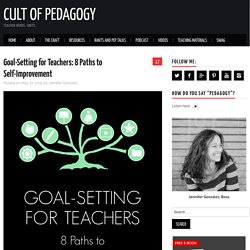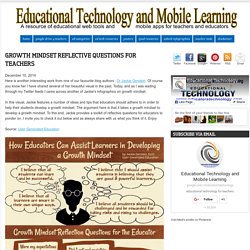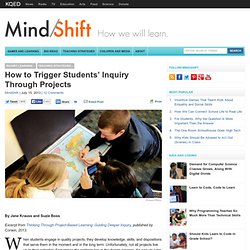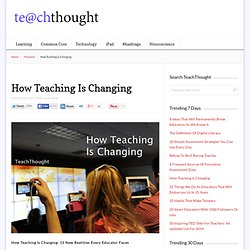

Powerful Learners - #PowLearn. Projects. Goal-Setting for Teachers: 8 Paths for Self-Improvement. Some links in this post are Amazon Affiliate links.

If you click these and make a purchase from Amazon, I will receive a small commission at no extra cost to you. Thanks for your support! One thing I love about teaching is that the list of ways you can improve is a mile long. It truly never gets boring. But because the work of a teacher has so many dimensions, it’s easy to get overwhelmed; you can’t possibly do it all. So instead of trying to tackle everything at once, I recommend you pick just one thing. Start by figuring out where you really need work: I have created an exercise called the Gut-Level Teacher Reflection that will help determine what areas of your practice need the most attention. Ready? I don’t know anyone who doesn’t have some room for growth with technology. Become a Google Educator. No matter how long a person has been teaching, there’s always room for pedagogical improvement.
Add some new teaching strategies to what you’re currently doing. Instructional Strategies. OakhillREAL. Let Students Learn From Failure. Too often, students–and teachers–believe learning comes from success when in truth, it’s as likely to be the product of failure.

Knowing what doesn’t work is a powerful weapon as we struggle to think critically about the myriad issues along our path to college and/or career. Could You Teach Without Grades? A few months ago, I started hearing about a new movement, where teachers were giving up traditional grading and finding new ways to measure student learning.

This group, launched by education writer Mark Barnes, calls itself Teachers Throwing Out Grades (TTOG) and now has a Facebook group and a weekly Twitter Chat. When I first became aware of the group, I admired their initiative, but the question that kept nagging at me was HOW? How do you do this, exactly? Growth Mindset Reflective Questions for Teachers. December 10, 2014 Here is another interesting work from one of our favourite blog authors : Dr Jackie Gerstein.

Of course you know her I have shared several of her beautiful visual in the past. Today, and as I was wading through my Twitter feeds I came across another of Jackie's infographics on growth mindset. In this visual, Jackie features a number of ideas and tips that educators should adhere to in order to help their students develop a growth mindset. The argument here is that it takes a growth mindset to develop a growth mindset. Ped-to-Heut-Diagram-v.2.1.jpg (JPEG Image, 1010 × 436 pixels) Resources for Assessment in Project-Based Learning.
How to Trigger Students’ Inquiry Through Projects. Inquiry Learning Teaching Strategies Krauss/Boss By Jane Krauss and Suzie Boss Excerpt from Thinking Through Project-Based Learning: Guiding Deeper Inquiry, published by Corwin, 2013.

When students engage in quality projects, they develop knowledge, skills, and dispositions that serve them in the moment and in the long term. Unfortunately, not all projects live up to their potential. 11 Bad Teaching Habits That Are Stifling Your Growth. 11 Bad Teaching Habits That Are Stifling Your Growth by Saga Briggs, opencolleges.edu.au There’s a certain class of mistakes that all educators can eliminate with conscious effort, and in this post we outline 11 of them.

They range from habits of practice to habits of thought, but all of them have one important thing in common: they make your job harder. Making Learning Meaningful: 6 Priorities For Whole Learning. Making Learning Meaningful: 6 Priorities For Whole Learning by Mark Basnage, Director of Academic and Institutional Technology, Prospect Sierra School Editor’s Note: We recently discovered the Bay Area’s Prospect Sierra School’s interesting learning model that prioritizes 6 ideas for learning in the 21st century.

There is, of course, no single “best” way to pursue “21st century learning”–nor any learning at all for that matter. But seeing the way other inspired educators pursue the idea can teach each one of us a lot. In this model, we appreciate the inclusion of self-knowledge, as well as moving past the idea of content to true disciplinary knowledge–seeing knowledge in context and application. You can find their site at the link above, and their twitter feed here, and their facebook page here. 1.
Build and apply content knowledge to think deeply and act as a practitioner of the discipline Students need to be able to connect the information they learn with how it’s used in the field. 2. Poles of Learning, Snappers, and Making the Time - Matt Ives. People tend to dichotomise teaching and learning into handy, easy to digest concepts.

Student led, good; teacher led, bad. Teaching Videos. Each one of our made-from-scratch videos has been created to help you become a better teacher.

We look at instruction and assessment strategies, classroom management, technology, presentation and design. Every effort is made to make each concept clear and simple. Most of our videos contain small, brief advertisements. How Teaching Is Changing: 15 Examples. How Teaching Is Changing: 15 New Realities Every Educator Faces.

Teaching, learning and leading / Pedagogical leadership / Pedagogy and assessment / Home - Educational Leaders. Pedagogy. Social for Education. Education. International PBL research. Problem-based learning: future challenges for educational practice and research - Dolmans - 2005 - Medical Education. Changing culture & leadership. My Reading List: Unread.